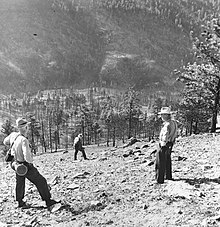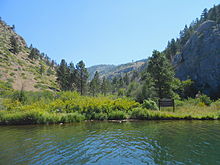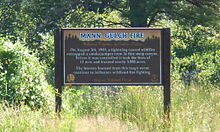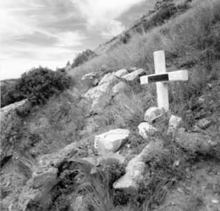Man gulch forest fire

On August 5, 1949, 13 United States Forest Service firefighters died in a bushfire in Mann Gulch , a notch valley in the Gates of the Mountains Wilderness on the Upper Missouri River in Montana, USA . For 25 years the fire went largely unnoticed until Norman Maclean , a retired Renaissance literature professor, put material together for a book. Maclean's book, Young Men in Fire , published posthumously in 1992, brought the incident to America's collective memory and made the forest fire the most famous in US history.
procedure
The Mann Gulch is a small notched valley that flows from the east in Lewis and Clark County in central Montana into the upper reaches of the Missouri River , which runs from south to north . It is located at 1080 m above sea level in the northern part of the Big Belt Mountains , around 40 km northeast of the capital Helena in the Helena National Forest . The slopes of the valley are steep and deeply cut. The upper end of the north slope is a rock step exposed by erosion , which rises vertically between 3.60 and 6 m. In August 1949 the valley was completely dry; the southern slope was densely wooded with Douglas fir , between which stood yellow pines and some juniper . On the northern slope near the mouth of the river there were yellow pines, which became increasingly sparse both towards the ridge and into the upper valley and merged into grassland.
Back then, the valley could only be reached by land by walking several hours; there are still no roads nearby. On August 4, 1949, a fire was probably started in Mann Gulch by lightning. By the following day, the fire had expanded into a forest fire. As was common with fires in rough terrain, a unit of fire jumpers was alerted. Under the guidance of “Wag” Wagner Dodge, 16 experienced fire jumpers between the ages of 17 and 28 climbed a Douglas C-47 in the direction of the fire. In the turbulent flight, one of the men lost his nerve, returned by plane and quit duty immediately after landing.
The fire jumpers jumped off with their equipment at 4:10 p.m. The radio parachute failed and the device was destroyed. The crew gathered on the ground and met Ranger Jim Harrison, who had come on foot from his observation point several hours away, had already fought the fire on his own and was introducing Dodge to the landscape. The fire at the time was very concentrated on the ridge south of the Mann Gulch and seemed like a problem-free task.
Dodge's deputy, William Hellman, was hired to lead the crew across the valley and down towards the estuary, as Dodge and Harrison feared they would be trapped by the fire in the thick wood on the south flank. Therefore, fighting from below should be done with the safe flow behind you. Hellman led the team to the other side of the valley. Dodge and Harrison caught up with the team and Dodge took the lead. As he descended, Dodge saw that the fire had jumped the side of the ditch about 200 meters below them and was now also rising on the north flank. He turned and ordered the escape. Until everyone understood the situation, Dodge led the escape up the valley as the fire came towards them.
Dodge ordered the tools to be thrown away for speed. When Dodge realized there was no escape, he stopped, lit the grass in front of him, and called to the men to go into the ashes of the escape fire. A few seconds were enough to create a large enough patch of ash to lie in. Nobody obeyed orders, only Wagner Dodge confided in the counterfire and thus saved his life. After about 14 minutes he was able to get up unharmed and leave the area of the fire despite some trees and tufts of grass still burning.
Two of the men - Sallee and Rumsey - stayed close together, running up a steep hill, and escaping through a crack in the rock step over the ridge to safety. Hellman and Joseph Sylvia also reached the safe side uphill, but succumbed to their severe burns shortly after the fire or the following day. All the others ran roughly parallel to the slope into the valley, were overtaken by the fire depending on their individual speed and died.
After the fire continued, Rumsey stayed with the two seriously injured while Dodge and Sallee ran to the nearest base for help. The two burned men were picked up the following morning, but never made it to the hospital alive. Several hundred firefighters put out the fire during the day.
analysis
The fire in the Mann Gulch has been studied from various angles. There are two explanatory models for how the fire below the crew could jump over the ditch: either through downdrafts as a result of a thunderstorm front or through turbulence of the wind at the mouth of the side valley, which is related to the turning of the wind in southerly directions. At Maclean's request, the Forest Service undertook a reconstruction of the process using software that was only developed in the 1980s and which allowed the spread of fire depending on vegetation, drought, winds and other factors. Accordingly, the escape into the valley was hopeless for the fire crew. After the fire jumped the trench to the north flank, it spread in the crowns of the yellow pines in about ten minutes. Once the fire reached the edge of the closed forest and spread into the tall, dry grass, its rate of spread increased rapidly to an estimated 185 meters per minute (610 ft / min). In the pathless, steep terrain, people could not run away from him. Ten to fifteen minutes later, even the four fastest of them were dead.
Dodge survived because he paused and considered. According to his own statements, the fire was around 30 seconds away from him when he had the idea of the counterfire . The technique is described for prairie fire, for example, by James Fenimore Cooper in his novel The Prairie . According to his own statements, Dodge was not familiar with this method because he had fought forest fires but never prairie fires. He had a book of matches in his pocket and despite the adverse circumstances he managed to ignite the grass around him.
The American organizational psychologist Karl E. Weick investigated the misfortune in the Mann Gulch, since the small group of people and the meticulous preparation of Maclean were particularly suitable for the analysis. Weick justifies the cause of the accident with the fact that the simple organization of the fire jumpers was weakened by the circumstances until the organization ceased to exist. At the same moment there was no understanding of the situation. It suddenly no longer made sense to the men and they had no time to find it again.
Weick attributes the survival of Sallee and Rumsey to the fact that they acted together and received part of the organizational consciousness, whereby their abilities were sufficient for survival. Weick regards the survival of Dodge as an indicator of its ability to implement a solution in the crisis with the means available. This property is referred to as bricolage based on Claude Lévi-Strauss . Weick sees bricolage as a factor that can increase the resilience of organizations when the environment becomes too dynamic for more rational methods.
consequences
Not much attention was initially paid to the Mann Gulch fire. It was not particularly extensive, the number of victims was not outstanding, and the damage was not particularly great. Like all fires that cost human lives, it was examined by the Forest Service according to the standards of the time. The hearings revealed no individual guilty behavior and no guilty party. Lawsuits from four parents in the federal court were denied.
It wasn't until the 1970s, around 25 years after the forest fire, that retired Renaissance literature professor Norman Maclean began researching and presenting the story. He worked on the book for 14 years, until his death. In retirement he wrote other books, including A River Runs Through It , which was filmed by Robert Redford as A river rises from the middle . The book on Mann-Gulch-Feuer appeared posthumously in 1992 under the title Young Men and Fire . It won the National Book Critics Circle Award and became a bestseller. As a young man, Maclean himself had worked in forest fire crews for the Forest Service and represented the eternal conflict between man and nature in a new way by not only depicting the characters of the men, but treating the fire as a character of its own. The book also became important because Maclean researched and prepared the events meticulously and thus laid the basis for later analyzes and interpretations.
While Maclean was working on his book, the Forest Service continued to develop. The safety of fire fighters was given a much higher priority in training and equipment. In 1977 Fire Shelters were introduced, structures reminiscent of igloos made of wire hangers with an insulating layer and reflective aluminum foil, which, when unfolded, can completely cover a man in order to provide a last protective layer between his body and the fire in the worst case. Since the 1980s, forest fire crews have initially created escape zones that are cleared of all vegetation before they approach the fire. In the meantime, every firefighter also wears an individual radio.
But it was only through Maclean's book that the Mann Gulch Fire gained its role as a didactic piece for fighting forest fires and as an example for organizing working groups, leading people and dealing with risks. When 14 wilderness firefighters died in the South Canyon Fire under similar circumstances shortly after the book was published in Colorado , the US Forest Service put its safety culture to the test and, above all, systematized the training of its employees in fire-fighting. Maclean's book has changed the methodology of the Forest Service more than any other development of the 50 years before. The Forest Service has only been analyzing previous forest fires at the location of the fire since the book was published as part of the training of new employees. The Forest Service has been bringing forest fire crews to the Mann Gulch site since 1994 so that they can study the terrain and its risks. But USFS group leaders and planners for dealing with forest fires also work with the events of 1949.
Economists examined the events in the Mann Gulch from the perspective of organizational psychology, the structure of companies, project groups and leadership. For example, a health scientist made the forest fire in a speech about strategies in emergency situations. But since then, and to this day, books about decision-making and creativity refer to the events and primarily to the spontaneous actions of Wagner Dodge on the one hand and the rash escape of the other men.
In other respects the book and its subject came too late. The Forest Service had begun reassessing the role of fire in the forest since around 1980. For disturbance ecology , fire is an environmental factor that belongs to forest ecosystems and plays a necessary role there. This knowledge gained acceptance after the fires in Yellowstone National Park in 1988 in the 1990s and has been the basis for dealing with forest fires in the USA ever since. A fire like the one in Mann Gulch from 1949 would only be observed today. Since it does not endanger human life or values, it would continue to burn in the wild under the applicable guidelines. It happened in 2007 when a fire burned again in the Mann Gulch.
In 1949 it was different. Every forest fire was seen as a threat to the economically important wood stocks. The goal set up after the great fire of 1910 to fight every forest fire directly had been specified since 1935 so that every fire should be extinguished by 10 a.m. on the day after it was discovered. The fire jumpers had existed since 1939, and since 1942 the film Bambi had presented forest fires as an existential threat to a population increasingly alienated from natural processes. Maclean and his book were still stuck with this attitude, he rejected suggestions from his interlocutors in the Forest Service to take up these aspects.
A memorial for the victims was erected at the site of the accident. Originally thirteen crosses on the places where the bodies were found remind of the victims; two of the crosses stand above the rock step where Hellman and Sylvia were found badly burned. In May 2001 one of the crosses was exchanged for a marking with a Star of David because one of the victims, David Navon, was Jewish. The memorial has been listed on the National Register of Historic Places as the Mann Gulch Wildfire Historic District (No. 99000596) as of May 19, 1999 . Under the influence of the incident, the film The Fire Jumpers of Montana with Richard Widmark in the lead role (directed by Joseph M. Newman ) was made in 1952 .
literature
- Norman Maclean 1992 Young Men and Fire Chicago: University of Chicago Press; German: 1994 Young Men in Fire .
- Richard C. Rothermel: Mann Gulch Fire: A Race That Couldn't Be Won , United States Forest Service, Intermountain Research Station, General Technical Report INT-299, 1993 (also online , PDF; 662 kB)
- Karl E. Weick: The Collapse of Sensemaking in Organizations: The Mann Gulch Disaster ; Administrative Science Quarterly, 38 (1993), pp. 628–652, (also online , PDF; 1.5 MB)
- Kathryn Schulz, The Story That Tore Through the Trees ; New York Magazine September 9, 2014
Web links
- Rod Benson: Mann Gulch Virtual Field Trip , Montana's Earth Science Pictures - Extensive collection of photos and texts to classify the forest fire of that time.
- US Forest Service: Summary Report 1949 (English)
- US Forest Service: Transcript of Review Board Hearing , 26-28. September 1949 (English)
swell
- ↑ a b c d e Kathryn Schulz, The Story That Tore Through the Trees ; New York Magazine September 9, 2014; Retrieved September 20, 2014.
- ↑ Excerpt (English) from Young Men and Fire by Norman Maclean
- ↑ a b c d e Richard C. Rothermel (May 1993): Mann Gulch Fire: A Race That Couldn't Be Won ; United States Department of Agriculture, Forest Service, Intermountain Research Station, General Technical Report INT-299;
- ^ A b c d e f g Karl E. Weick, 1993: The Collapse of Sensemaking in Organizations: The Mann Gulch Disaster ; Administrative Science Quarterly, 38; 628-652, online (PDF; 1.5 MB)
- ^ Claude Lévi-Strauss (1966) The savage mind ; University of Chicago Press; Chicago; cited in Raffi Duymedjian and Charles-Clemens Rüling (2010) Towards a Foundation of Bricolage in Organization and Management Theory ; Organization Studies 31 (2): 133-151; ISSN 0170-8406 .
- ↑ Mark Mathews: Questioning Man Gulch . On: Wildfire Lessons, Spring 2009
- ↑ Donald Berwick: Escape Fire , 1999 speech (video on Youtube)
- ↑ The Missoulian: A Star for David , May 11, 2001
- ^ Mann Gulch Wildfire Historic District on the National Register Information System. National Park Service , accessed November 17, 2018.
Coordinates: 46 ° 52 ′ 42 " N , 111 ° 54 ′ 48" W.



